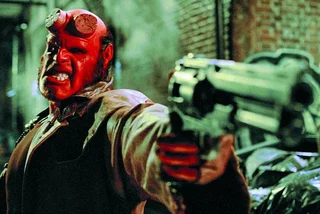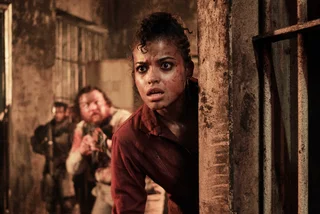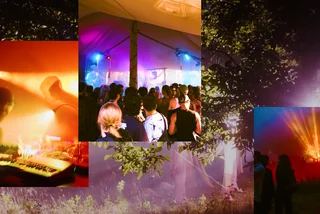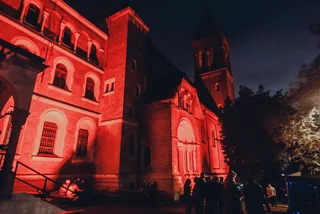Introducing a new podcast from Expats.cz, Expats Extra. Think of it as the cutting board of our newsroom, where snippets from our stories, behind-the-scenes reporting, and surprising soundbites come together each week. You can listen to the podcast on Spotify, Apple Music, or Podbean.
SHOW NOTES: Bits and bytes for Nov. 7, 2025
Elizabeth Zahradnicek Haas: The story of Czech food culture told by tiny plates, zombies turning Karlín into a Hollywood backlot, and a secret society of ravers keeping Prague’s electronic pulse alive. This is Expats Extra, a news podcast from Expats.cz. Fresh stories, surprising soundbites, and extra insights beyond the headlines.
On today’s episode, we’ll discuss why filmmakers can’t get enough of Prague’s horror aesthetic, unpack the economics of the underground club scene, and step into a packed bookstore to celebrate the two-decade legacy of La Degustation.
How La Degustation Reclaimed Czech Cuisine (and won a Michelin star)
EZ: It’s a rainy afternoon in Prague, and I’m squeezed into a packed bookstore in the city’s Vinohrady district. Why? Because Tomáš Karpíšek, Czechia’s most successful restaurateur, is about to perform a ceremonial act: pouring champagne over a nondescript black book. That book, which Karpíšek is about to christen, represents two decades of advancing Czech food culture. How it tastes, how it looks, and how it is served. It’s the full, powerful story of La Degustation, one of Prague’s only two Michelin-starred restaurants.
EZ: So what does the Czech Republic truly taste like? That is a question The Ambient Group, celebrating its thirtieth anniversary this year, has been at the forefront of answering since launching its first restaurants decades ago. And at the heart of that mission sits their Michelin-starred pioneer, La Degustation. Nearly twenty years ago, this restaurant set out to prove that humble Czech dishes like svíčková or rohlíky could earn international recognition. It succeeded in 2012 with a Michelin star. Now that full story is being told in a new book.
EZ: The author is Blanka Duczynska, a gastro storyteller whose work explores the roots and spirit of Central European food. Blanka spent two years documenting this legacy and she spoke to us about her research. La Degustation was truly a pioneer. What were some of the firsts it introduced that changed Czech gastronomy forever?
BD: La Degustation was the first Czech restaurant to offer only a tasting menu and to receive a Michelin star for local cuisine in the Czech Republic, but also in the countries of the former Eastern Bloc. It was not the first Michelin star in our country, but it was clearly the first star for the Czech culinary tradition and landscape. And it is one of the first restaurants to elevate traditional cuisine like knedlíky, guláš, or Spanish bird to the level of fine dining.
BD: And also stood for the opinion that Czech cuisine should be cooked from Czech ingredients. I would not be afraid to say that it was also first in terms of access to people in the team and education. For example, many cooks got internships in the best restaurants in the world thanks to the restaurant. There are many firsts, but I think it’s not so much about being the first, but being consistent and persistent and doing things with a deep interest because then the restaurant has a real impact on gastronomy and
EZ: That commitment to the tasting menu was a radical, almost stubborn move at the time. Blanka told me the book wasn’t commissioned. It arose from what she called a need to document its broader significance. So where did she see that significance most clearly? Blanka dedicated a chapter called The School to the restaurant’s impact on people. What important lessons about precision, rigor, and respect did La Degustation pass on to the many chefs and waiters who started their careers there?
BD: While writing the book, I did many interviews with people who worked or are working in hotels. So based on this material, I would say that all the cooks and waiters learned what quality means. They learned a lesson about hospitality, honesty, courage and teamwork. They also learned how beautiful Czech cuisine can be, and I hope that the book will awaken this love in readers.
EZ: The restaurant took beloved traditional dishes, comfort food, and treated them with the same reverence reserved for haute cuisine. Finally, the food itself. How do you transform a hearty, homestyle svíčková or španělský ptáček into something refined enough to stand proudly on the global stage? What’s the secret behind that transformation?
BD: I hope the key is to be proud of svíčková or any other food. That’s all, because when we are proud enough of our culinary heritage, when we look up to our roots, then we can do the best and cook Czech cuisine at a world-class level. At La Degustation, they understand that it’s not necessary to cook differently, but it’s important to cook it in the best possible way with respect for the past and with regard to the present day.
EZ: That precision, perseverance, and respect for tradition. It sounds like the story of the restaurant is in many ways the story of Czech cuisine itself.
Hollywood Horror: Prague as a Cinematic Battleground
AM: If you visit the Expats.cz office anytime soon, you might see an unsettling sign: Zombies, gunfire, and car chases ahead. That’s because Resident Evil is filming right here in Karlín, as Prague once again transforms into a cinematic battleground. The Czech Audiovisual Fund granted the project nearly 191 million crowns, joining high-profile sci-fi and horror projects like Nosferatu and Blade Runner 2099.
AM: But what makes Prague such an irresistible setting for chasing monsters? The trend truly began twenty years ago with Guillermo del Toro’s Hellboy, which first put Prague on the global map for fantasy horror. Australian film expert Ryan Keating, who also hosts a weekly series of film talks at Edison Filmhub in Prague, traces the trend back to that director’s personal preference.
RK: More so I think it was Guillermo del Toro because he liked filming here so much, and he made Blade II, and then he decided to return to film Hellboy here. So I think it was kind of him that maybe led the way for some of these other big-budget horror and fantasy movies. Del Toro certainly made use of the atmosphere. Prague gave his dark imagination some truly fitting
RK: In Hellboy, the Vítkov Monument was the headquarters for Hellboy and the Bureau of Paranormal Research and Defense, which is B.P.R.D., which is a very, very cool location, I think, and I think a lot of people recognize it when they watch the movie and get quite excited by it. And then the Ministry of Transport in Prague was also used, and then there were some cemetery scenes that were filmed in Olšanský Cemetery. And then they did some random locations also in Holešovice and Smíchov.
AM: Since those early 2000s classics like Van Helsing and Alien Versus Predator, Prague has only become hotter. Today, Karlín is crawling with the undead from Resident Evil to The Gray Man. Jason Pirodsky, film critic and founder of The Prague Reporter, notes that the historical atmosphere still holds major appeal for filmmakers.
JP: f you’re looking for something a little more recent, one of my favorites horror movies filmed in Prague is definitely last year’s Nosferatu, and a lot of what adds to that atmosphere is the wonderful set design at Barrandov Studio and the locations, historical locations around the Czech Republic. And those include in Prague, Olšanský Cemetery and the Invalidovna complex in Prague
AM: But what keeps bringing them back? Is it just the cinematic locations or is there a more practical reason? Ryan Keating recently heard from Resident Evil’s director, Zach Cregger, at a screening at Edison Film Hub.
RK: He talked briefly about making his new Resident Evil movie, and he said that he’s excited to shoot both in and out of Prague because the locations are very cool. And he also mentioned that the Czech Republic is more accessible because of the cash rebates of 25 to 35%, which is a reason—a big reason, actually—why a lot of big budget films are made here. It’s a little bit cheaper.
AM: When we shared the news about the zombies in Karlín, everyone asked: Why that neighborhood? Jason Pirodsky explains why Karlín, particularly the Negrelli Viaduct, is the perfect stand-in for anywhere else in the world.
JP: The Karlín district in Prague is a popular location for filmmakers because it has been rebuilt in recent years and features a lot of locations that can easily stand in for anywhere else in the world. Resident Evil is currently filming by the Negrelli Viaduct, and it’s presumably standing in for a location in the fictional Raccoon City in North America. And coincidentally, Blade II was also shot in the very same location, of course.
AM: Prague’s horror legacy isn’t just imported from Hollywood. The Czech film scene has produced some iconic and deeply unsettling works of its own.
JP: There are at least a couple standout classics from the Czech New Wave. One of those is The Cremator, which was Jiří Herz’s 1968 psychological drama, and another movie is Witch’s Hammer, which was about the real-life persecution of witches in 17th-century Moravia. And both of these movies, in addition to covering real-life chapters from Czech history, there were also pretty transparent criticisms of the Soviet regime in Czechoslovakia.
The New Pulse of Prague Nightlife
AM: We hear the headline: Clubbing is dead. Fewer young people out, less drinking. Traditional venues are struggling. It’s a massive global trend. But here in the heart of Europe, Prague’s nightlife is navigating a paradox. Mainstream clubs are taking a hit; the electronic underground pulse is beating harder than ever.
AM: The financial reality is brutal. Spiking costs, falling attendance. Attendance at Prague’s Fuchs2 dropped 26% this year. Visitor spending cut nearly in half—from 480 Czech crowns in 2023, now below 250. Entrance fees cover performers, that’s it. Bar sales are fatal. But the financial pressure didn’t kill the party. It forced an evolution.
AM: Rave culture moved into bizarre, beautiful, unconventional locations. Take Sound, an immersive event in the stunning Gabriel Loci monastery. Why choose a monastery basement over a standard club? Dan Bacho, organizer of Sound, weighs in.
DB: I think young people and clubbers in general are seeking new experiences. They’re looking for something special. Gabriel Loci is a really special place with a unique atmosphere. It was not built for parties, was not built for concerts, but for people coming to the show, it’s immersive.
AM: A logistical nightmare to produce, but the experience is everything.
DB: I wouldn’t say traditional clubs are losing appeal, but those clubs in Prague, as far as I know, could struggle a little bit with attracting young people. I think I’m talking about eighteen, twenty, twenty-five years old.
AM: Bringing that new stuff takes work, but it pays back.
DB: You have to bring everything, I don’t know, starting with toilets, going to lights, sound system. We have big rooms, small rooms, underground crypt, for example. Gabriel is a very special place, but it pays back.
AM: This scene is fueled by community and accessibility. DJ Poperz, Deniz, is part of that movement in Prague.
DP: In underground parties, we all try to make it accessible for everyone. Like financially, there are parties which are so expensive and it’s unfortunately not accessible for everyone, especially young people. It’s a safe space rooted in history. I’m so grateful that we have this environment and the safe space for everyone. This music, house, disco and techno, they all came from queer and black people. These people needed some safe space to enjoy and have fun.
AM: The biggest difference from global hotspots like Ibiza? Presence. Not Proof.
DP: I’ve been in Ibiza recently and oh my God, I really felt the difference. Ibiza got so commercialized and people are just going there to show off and they’re all on their phones. In Prague, most of the events have a no phone policy because we actually want people to be present, to be in that moment. As DJs, we are creating a story with our music.
DP: The economic squeeze ignited this resilient culture. But how long can it last? Even the most beloved spots are on a razor’s edge. Deniz noted the minimal state aid for one of Prague’s essential venues, for example, Ankali.
DP: This year, they were on the edge of closing. The government only cover ten percent of their whole spendings for the club. Is it really enough? I don’t think so.
AM: The only solution is to adapt. Multi-genre spaces are holding steady, and in the underground, the answer is relentless innovation fueled by a fierce community.
DP: These years, it’s very important for a promoter to bring new stuff, bring new artists, to think about the variety of music styles to attract as many people as it’s possible.
AM: But ultimately, this scene survives on something much less quantifiable: the deep personal loyalty to the places that foster this culture.
DP: We have other underground clubs, of course, but Ankali is always going to have a different, different part in our hearts. Thank God we still have it. We will have it for some time.
This episode of Expats Extra was written, researched, and reported by Elizabeth Zahradnicek Haas and Anica Mancinone. Anica Mancinone edited it with additional audio editing by Daniel Zahradnicek. Follow Expats Extra wherever you get your podcasts so you never miss a story.





